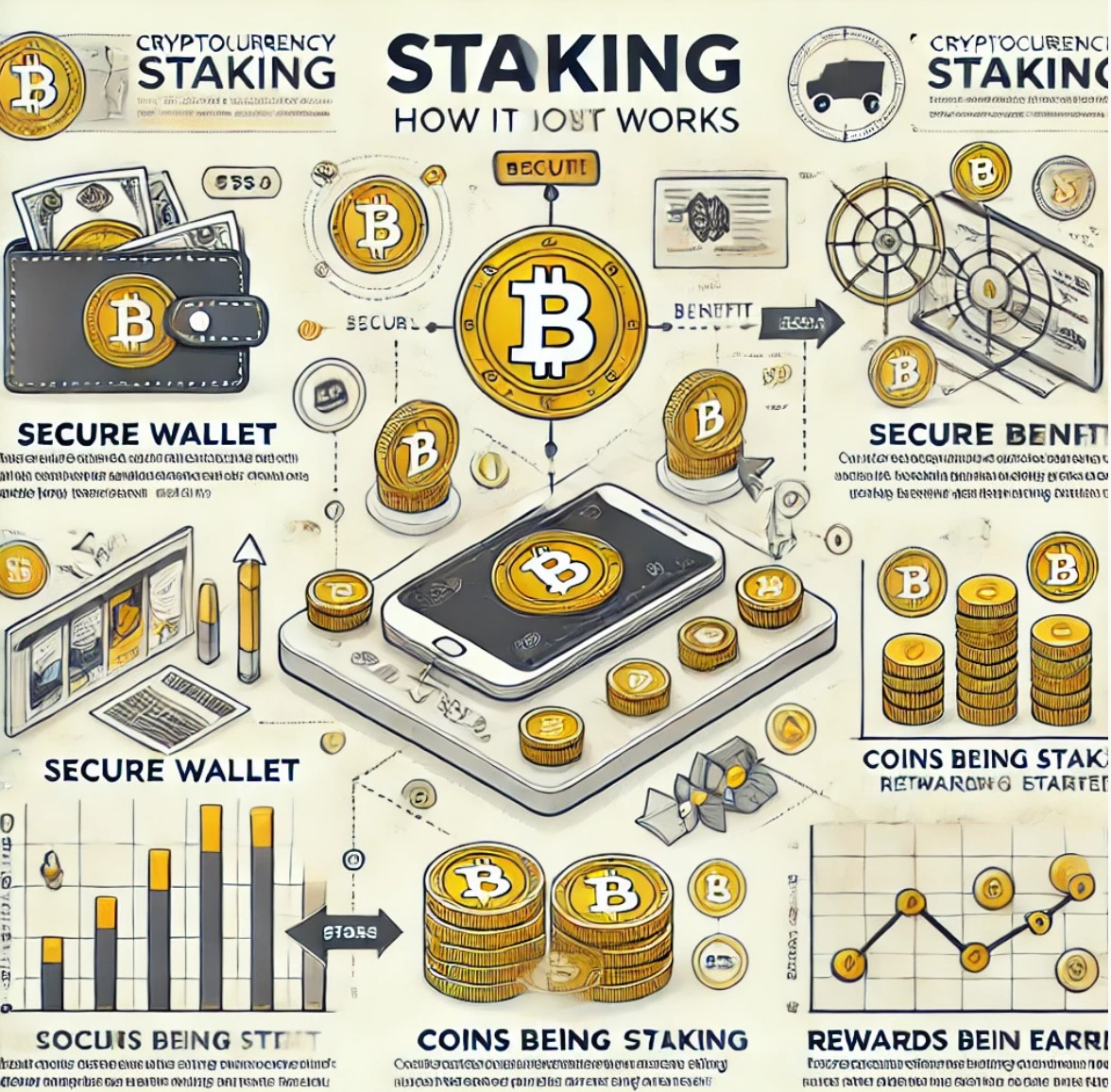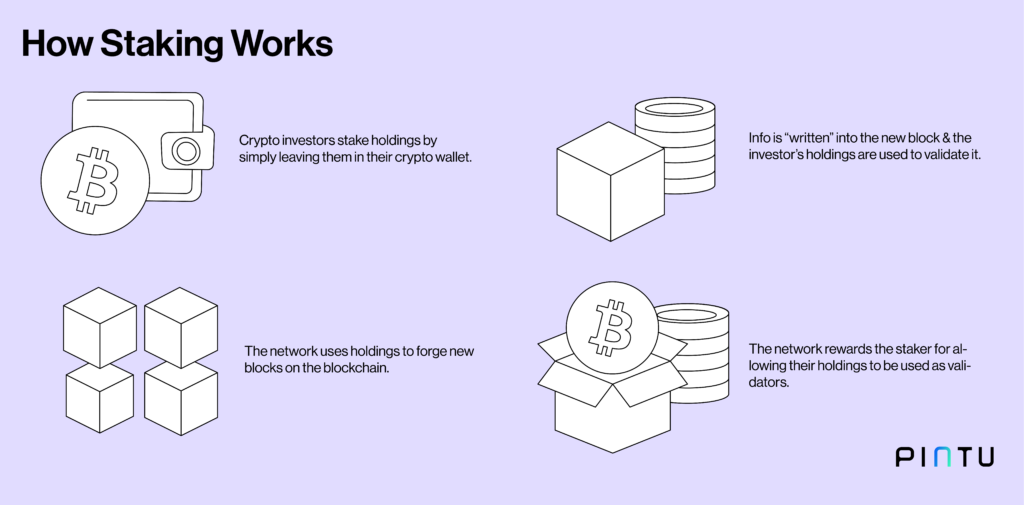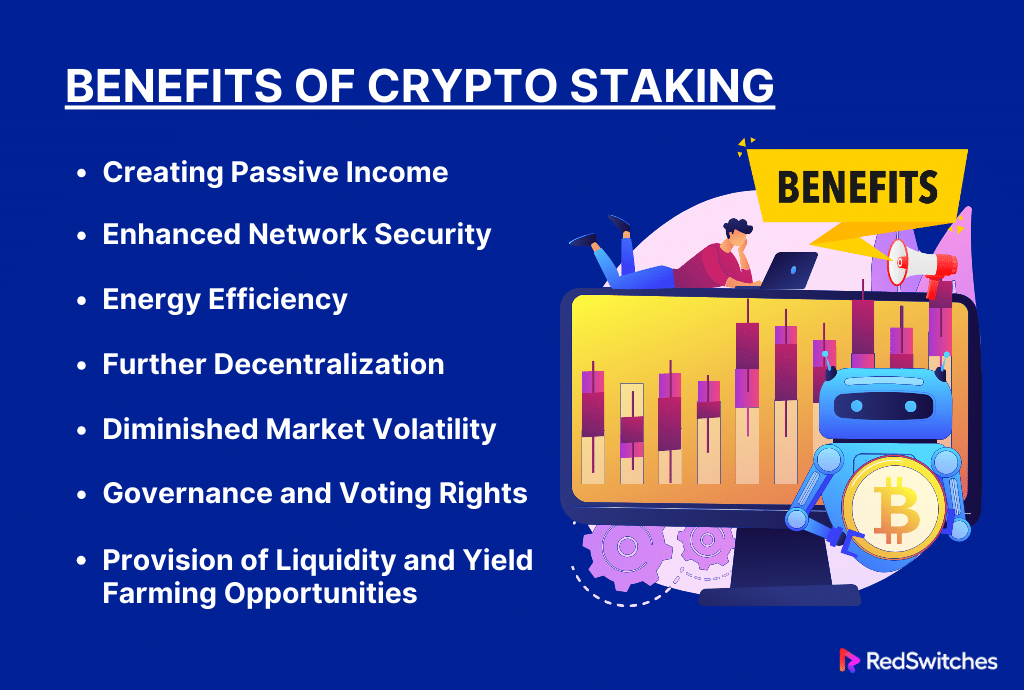

What Is Crypto Staking & How Does It Work?
Staking allows you to earn rewards by contributing your crypto assets to support a blockchain network. By helping maintain its operations and security, you receive additional units of the respective different kinds of cryptocurrencies you’ve staked.
Introduction to Crypto Staking
Crypto staking has emerged as a popular way for both cryptocurrency traders and holders to earn passive income while supporting blockchain networks. By committing their assets to the network, participants help validate transactions, secure the blockchain, and are rewarded in return. This guide will explore the concept of crypto staking, how it works, and its benefits and risks. While TMGM focuses on CFD trading, understanding staking can offer valuable insights into the broader cryptocurrency market and help you make informed trading decisions.
What is Crypto Staking?
Definition of Crypto Staking
Crypto staking is a process where cryptocurrency holders commit their assets to support a blockchain network and confirm transactions. It's a way of validating cryptocurrency transactions that use the proof-of-stake consensus mechanism.
How Crypto Staking Works
The Initial Crypto Staking Explained
Users lock up a portion of their cryptocurrency in a wallet.
This staked amount acts as collateral to validate transactions.
Node Selection in Staking Networks
The network selects validators (nodes) based on the amount staked.
Generally, the more you stake, the higher your chances of being chosen to validate transactions.
Transaction Validation in Crypto Staking
Selected nodes validate new transactions.
Upon successful validation, a new block is added to the blockchain.
Reward Distribution in Staking Systems
Validators receive rewards in the form of additional cryptocurrency.
Rewards are typically proportional to the amount staked.
TMGM Perspective: While TMGM doesn't offer direct staking services, understanding this process can help traders anticipate market movements in proof-of-stake cryptocurrencies.
Proof-of-Stake vs. Proof-of-Work
Proof-of-Stake (PoS) in Crypto Staking
Uses staking to validate transactions
More energy-efficient
Typically, faster transaction times
Proof-of-Work (PoW) vs Crypto Staking
Uses computational power to solve complex puzzles
More energy-intensive
Used by cryptocurrencies like Bitcoin
TMGM Offering: TMGM provides CFD trading on PoS and PoW cryptocurrencies, allowing traders to take advantage of price movements regardless of the underlying consensus mechanism.
Benefits of Crypto Staking
Generating Passive Income with Crypto Staking
Staking crypto enables investors to earn passive income by locking digital assets into a blockchain network. Unlike active methods like day trading, staking allows users to generate rewards without the need to time the market or execute frequent trades.
How Crypto Staking Enhances Network Security
Staking plays a critical role in securing proof-of-stake networks. By incentivizing validators to act honestly, the network maintains its integrity. This long-term alignment contrasts with spot trading, which focuses on short-term price movements and immediate asset ownership.
Energy Efficiency in Crypto Staking vs Mining
PoS systems consume significantly less energy than PoW systems.
Potential for Appreciation in Staked Assets
While your assets are staked, they can still rise in value. Traders often evaluate appreciation potential using technical analysis indicators like Fibonacci retracement, especially when analyzing staking-related coins for long-term growth.
TMGM Alternative:
While TMGM doesn't offer direct staking, traders can profit from price movements of staking-related cryptocurrencies through CFD trading.
Risks and Considerations in Crypto Staking
Volatility Risk When Staking Crypto
The value of staked assets and rewards can fluctuate dramatically.
Liquidity Risk in Crypto Staking Platforms
Staked assets are typically locked up for a period, reducing liquidity.
Technical Risks in Crypto Staking Systems
Potential loss of staked assets due to system malfunctions
Risk of losing stake if node is unavailable when called upon
Regulatory Risks in Crypto Staking Environments
Evolving regulations may impact how staking platforms operate or how rewards are taxed. Staying updated on regulatory trends is essential to avoid unexpected changes in earning potential or platform compliance.
TMGM Risk Management:
When trading crypto CFDs on TMGM, use stop-loss orders and proper position sizing to manage risks associated with cryptocurrency volatility.
Popular Cryptocurrencies for Crypto Staking
Ethereum 2.0 and Crypto Staking Evolution
Transitioning from PoW to PoS.
Staking Cardano (ADA) for Passive Rewards
Designed with a PoS system from the outset.
Staking Polkadot (DOT) via Proof-of-Stake
Uses a nominated proof-of-stake (NPoS) system.
Staking Tezos (XTZ) on Blockchain Networks
Pioneered the concept of "liquid proof-of-stake".
TMGM Trading Opportunities: TMGM offers CFD trading on various cryptocurrencies, including those that use proof-of-stake systems.
Crypto Staking vs. Other Crypto Strategies
Staking vs. Mining in Crypto Explained
Staking: Holding and "locking" coins
Mining: Using computational power to solve cryptographic puzzles
Staking vs. Yield Farming: Key Differences
Staking: Generally simpler, often with lower returns
Yield Farming: More complex, potentially higher returns but higher risk
Staking vs. Traditional Crypto Trading
Staking: Passive income strategy
Trading: Active strategy requiring market analysis and frequent decisions
TMGM Trading: While TMGM doesn't offer direct staking or yield farming, it provides a platform for actively trading crypto CFDs.
How to Get Started with Crypto Staking
Choose a Proof-of-Stake Cryptocurrency to Stake
Research various PoS cryptocurrencies and their staking requirements.
Acquire the Chosen Cryptocurrency for Staking
Purchase the cryptocurrency through an exchange.
Select a Staking Method That Suits You
Exchange staking
Wallet staking
Joining a staking pool
Stake Your Crypto and Start Earning Rewards
Follow the specific process for your chosen method and cryptocurrency.
TMGM Alternative: If you're interested in profiting from cryptocurrency price movements without the complexities of staking, consider trading crypto CFDs on TMGM's platform.
Future of Crypto Staking
Growing Adoption of Crypto Staking
More cryptocurrencies are moving towards PoS systems.
Institutional Interest in Staking Cryptocurrencies
Increasing involvement from institutional investors in staking.
Regulatory Developments Around Crypto Staking
Evolving regulations may impact the staking landscape.
TMGM Commitment: TMGM stays abreast of cryptocurrency market developments to provide up-to-date trading opportunities and insights.
Remember, while crypto staking can offer rewards, it also carries risks. Conduct thorough research and consider your financial situation before engaging in cryptocurrency activities. If you're interested in trading cryptocurrencies without the complexities of staking, consider exploring TMGM's crypto CFD offerings.
Trade Smarter Today




Frequently Asked Questions
What Cryptocurrency supports staking?
Which crypto is best for staking?
How much money can I make from staking crypto?
How does crypto staking work?
Is staking crypto a good idea?


Account
Account
Instantly








